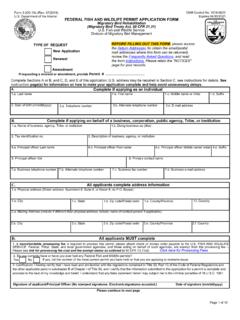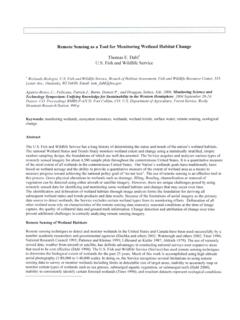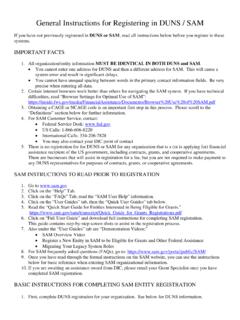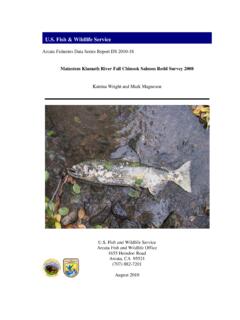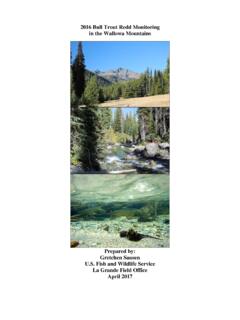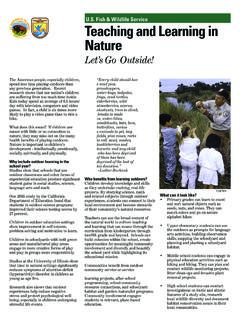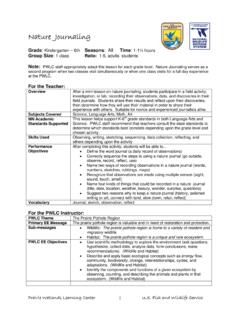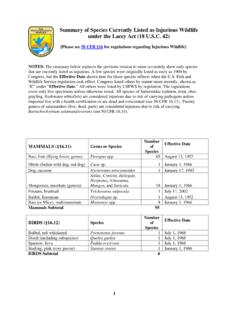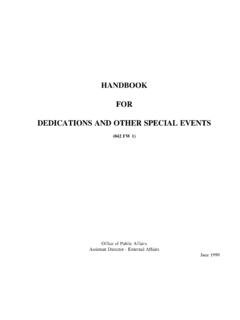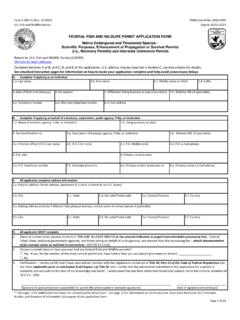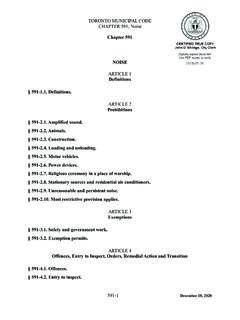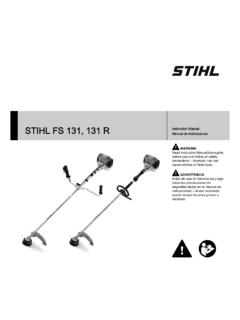Transcription of U.S. Fish & Wildlife Service Native Plants for Wildlife ...
1 Native Plants forWildlife Habitat andConservation LandscapingChesapeake Bay Fish & Wildlife ServiceAcknowledgmentsContributors: Printing was made possible through the generous funding from Adkins Arboretum; Baltimore County Department of Environmental Protection and Resource Management; Chesapeake Bay Trust; Irvine Natural Science Center; Maryland Native Plant Society; National Fish and Wildlife Foundation; The Nature Conservancy, Maryland-DC Chapter; Department of Agriculture, Natural Resource Conservation Service , Cape May Plant Materials Center; and Fish and Wildlife Service , Chesapeake Bay Field Office. Reviewers: species included in this guide were reviewed by the following authorities regarding Native range, appropriateness for use in individual states, and availability in the nursery trade: Rodney Bartgis, The Nature Conservancy, West Virginia.
2 Ashton Berdine, The Nature Conservancy, West Virginia. Chris Firestone, Bureau of Forestry, Pennsylvania Department of Conservation and Natural Frye, State Botanist, Wildlife and Heritage Service , Maryland Department of Natural Hollins, Sylva Native Nursery & Seed A. McAvoy, Delaware Natural Heritage Program, Delaware Department of Natural Resources and Environmental Pat Rowan, Landscape Architect, Maryland Native Plant Simmons, Maryland Native Plant Sterling, Wildlife Resources Section, West Virginia Department of Natural Weldy, Associate Botanist, New York Natural Heritage Program, New York State Department of Environmental Design and Layout: Laurie Hewitt, Fish and Wildlife Service , Chesapeake Bay Field Office.
3 Special thanks to: Volunteer Carole Jelich; Christopher F. Miller, Regional Plant Materials Specialist, Natural Resource Conservation Service ; and R. Harrison Weigand, Maryland Department of Natural Resources, Maryland Wildlife and Heritage Division for assistance throughout this project. Citation: Slattery, Britt E., Kathryn Reshetiloff, and Susan M. Zwicker. 2003. Native Plants for Wildlife Habitat and Conservation Landscaping: Chesapeake Bay Watershed. Fish & Wildlife Service , Chesapeake Bay Field Office, Annapolis, MD. 82 of Contents Introduction Benefits of Conservation Landscaping ..3 Why Use Native Plants .
4 4 Conservation Landscaping Elements ..4 How to Choose Plants ..6 Where to Find Native Plants ..6 How To Use This Guide Plant Names and Types ..7 Characteristics ..7 Growth Conditions ..8 Habitat ..9 Native To (Where to Use) ..9 Wildlife Value ..10 Notes ..10 Plant Information Pages Ferns ..11 Grasses & Grasslike Plants ..14 Herbaceous Plants ..18 Herbaceous Emergents ..41 Shrubs ..45 Trees ..54 Vines ..64 Plants with a Purpose Plants for Coastal Dunes ..66 Plants for Saltwater or Brackish Water Marshes ..66 Plants for Freshwater Wetlands and Other Wet Sites.
5 67 Plants Appropriate for Bogs or Bog Gardens ..68 Plants for Dry Meadows ..68 Plants for Wet Meadows ..69 Plants for Forest or Woodland Plantings ..69 Solutions for Slopes ..71 Evergreens ..72 Plants to Use as Groundcovers ..72 Plants for Spring and Fall Color ..72 Deer Resistant Plants ..73 Photo Credits ..74 References ..75 Index ..792To the ReaderThe use of Native Plants in landscaping and of course habitat restoration is certainly not new. In fact, their use has grown exponentially in recent years. Natural resources professionals in turn have been flooded with requests for information on Native Plants to use in various types of planting projects.
6 Communities, schools, businesses, nonprofit organizations, watershed groups, local governments, state and federal agencies and many others are enhancing and restoring habitat, solving ecological problems, reducing maintenance, or just beautifying surroundings, all using locally Native Plants . Natural resources professionals, in turn, have been flooded with requests for information on Native Plants to use in various types of planting projects. There are many excellent resources available on Native Plants - some more technical than others, some more comprehensive than others. The frustration voiced most frequently by users is the lack of color photographs of the Plants .
7 After all, it is the striking visual quality of these Plants that is their best selling point. This publication includes those pictures as well as user-friendly information on Native species appropriate for planting in the Chesapeake Bay watershed and adjacent coastal regions. Although one guide cannot furnish the answers to every question, we have included as much useful information as possible in a limited space. Although the large number of species of Plants included here may overwhelm some readers, this guide displays the great diversity of Plants available. We hope you will bypass the over-used, non- Native and sometimes invasive ornamental Plants , and select the equally and often more attractive Native Plants .
8 Pour through this guide the same way you look through nursery catalogs. Use it to plan and design your next planting, whether it s a small corner of your front yard, a two-acre meadow seeding, or 100 acres of wetland Plants for Wildlife Habitat andConservation Landscaping:Chesapeake Bay WatershedIntroduction Conservation landscaping refers to landscaping with specific goals of reducing pollution and improving the local environment. In the Chesapeake Bay watershed (the land that drains to the Bay and its many tributaries), this style of landscaping is sometimes called BayScaping, or beneficial landscaping provides habitat for local and migratory animals, conserves Native Plants and improves water quality.
9 Landowners also benefit as this type of landscaping reduces the time and expense of mowing, watering, fertilizing and treating lawn and garden areas, and offers greater visual interest than lawn. Beneficial landscaping can also be used to address areas with problems such as erosion, poor soils, steep slopes, or poor drainage. One of the simplest ways to begin is by replacing lawn areas with locally Native trees, shrubs and perennial Plants . The structure, leaves, flowers, seeds, berries and other fruits of these Plants provide food and shelter for a variety of birds and other Wildlife . The roots of these larger Plants are also deeper than that of typical lawn grass , and so they are better at holding soil and capturing of conservation landscapingAmericans manage approximately more than 30 million acres of lawn.
10 We spend $750 million per year on grass seed. In managing our yards and gardens, we tend to over-apply products, using 100 million tons of fertilizer and more than 80 million pounds of pesticides annually. The average homeowner spends 40 hours per year behind a power mower, using a quart of gas per hour. grass clippings consume 25 to 40% of landfill space during a growing season. Per hour of operation, small gas-powered engines used for yard care emit more hydrocarbon than a typical auto (mowers 10 times as much, string trimmers 21 times, blowers 34 times). A yard with 10,000 square feet of turf requires 10,000 gallons of water per summer to stay green; 30% of water consumed on the East Coast goes to watering practices described in this guide reduce the amount of intervention necessary to have attractive and functional landscaping.
